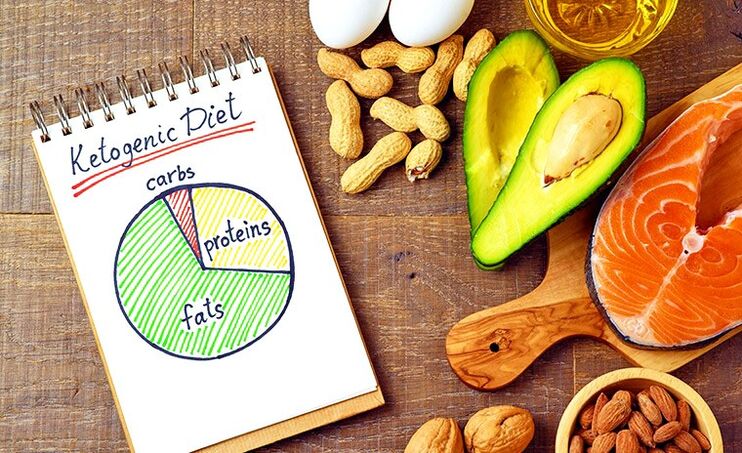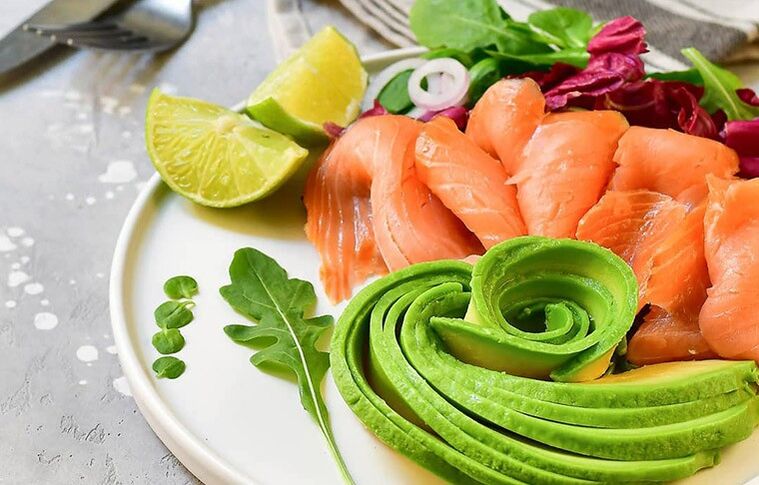
If someone put all the products in two baskets twenty or thirty years ago, sorted according to the principle of maximum and least usefulness, they need to examine them thoroughly today. The strangest story during this time has been fat - the recent main enemy of humanity is not only being fully rehabilitated, but almost declared its savior. That's right, nutritionist Chris More understands.
Recently, a patient admitted to me that she and her husband eat almost a kilogram of bacon a week - three slices for breakfast and then two more salads for lunch. I have been working as a nutrition expert for over twenty years and nothing seems to surprise me, but then I couldn’t resist and I asked: why? The patient said her husband was watching a TV show about the keto diet and they decided to give it a try. Six months on bacon - and the husband lost nine pounds and his wife said he was almost full of energy that flooded him.
I hear more and more from people about the miracles the keto diet is doing to them. They claim that they burn fat in the body, give energy and overcome diseases, and that from now on you not only need, but also need as much bacon as you want. But all their enthusiasm needs at least one serious test - is a keto diet that doesn’t limit animal fat intake really good?
The Ketogen diet is a low fat and medium protein diet. It was originally used to treat epilepsy in children by increasing the levels of ketone bodies in the blood.
What is ketosis?
Let’s start with the name of the diet: where did this "keto" come from? If your body is in desperate lack of carbohydrates, for example due to diabetes or prolonged starvation, you need to break down your own fat more actively than usual to gain energy. Ketosis develops: metabolism is disrupted and more ketone bodies accumulate in the tissues than necessary. Ketone bodies are products of fat metabolism. They are produced by the liver when insulin levels in the blood fall.
"The liver is constantly making ketone bodies, but their levels depend on the carbohydrates and proteins they consume - the body needs both, " explains Jeff Volek, a professor at Ohio University.
In the body of a healthy person, the breakdown of fat and the formation of ketone bodies is a normal process, called ketogenesis. Unlike ketosis, ketogenesis does not lead to dramatic weight loss. Ketosis is a pathology that, in addition to diabetes and prolonged fasting, can also be caused by the keto diet, as it almost excludes carbohydrate foods from the diet. A person with ketosis loses weight dramatically as well as other pathologies.
A ketogenic diet forces the body to use fat as its main source of energy. Usually, this role is played by carbohydrates, which are processed with food into glucose, which is extremely important for the nutrition and function of the brain. However, when there are few carbohydrates in the diet, the liver converts them into fatty acids and ketone bodies. Ketone bodies enter the brain and are used as an energy source instead of glucose. An increase in the level of ketone bodies in the blood (ketosis) leads to a decrease in the frequency of epileptic seizures.
In the keto diet, the main part of the daily diet - between 60 and 80% - is fats, proteins - about 15%, and only the remaining 10% carbohydrates (this is half a small bun). At first glance, it looks like the Atkins diet, but the keto diet has more severe carbohydrate restrictions, writes Spencer Nadolsky, author of The Fat Loss Prescription. Many theorists ensure that the less carbohydrates we eat, the more fat burns in our bodies, which improves metabolism, increases immunity - and usually various miracles begin to happen to our bodies.
In everyday life, however, we get about half the calories and not a tenth of the carbs. So essentially the question is: is your body able to be in ketosis long enough to reach the promised nirvana without serious health consequences? Are you going to quarrel with fat literally?
Is the keto diet adequate?
It may sound strange, but the best diet for you is the one you are used to following. For Volek, who has been a keto for twenty years, good, but right for you? Unfortunately, there is no research on what happens in the body of a person who has been on a keto diet for a long time. In the A to Z weight loss study, scientists studied the Atkins diet, zone, LEARN, and some other diets, but in the study, female subjects consumed 25 to 35% of carbohydrates — not even close to that. 10%, which is advised to limit yourself to a keto diet.
The only thing for sure: the keto diet will really lose weight. In Italy, the performance of those sitting on it was studied in 2015, and they lost about 10 to 12 kilograms on average over three months. A year earlier in Spain, it turned out that in a year, about 20 kilograms could be lost that way. True, the following year, subjects often returned to the weight they had before the experiment as soon as they quit their rigid diet.
What do you eat if you decide to give it a try? First and second, that bacon. Not many other products will match. Starchy vegetables - potatoes, pumpkins, corn - are strictly forbidden, as are most fruits. Milk, beans, rice and pasta should also be forgotten.
The keto diet is difficult to follow and can be dangerous for some. "Extreme diets, especially keto diets, are strictly contraindicated in people with neurodegenerative diseases such as epilepsy, " says Dr. Alan Aragon.
A ketogenic diet is considered optimal in society for weight loss. However, scientific evidence suggests that shortly after switching to a ketogenic diet, the effect of weight loss is caused by a decrease in the amount of water in the body, and the amount of body fat is affected solely by energy balance. To lose weight, the energy provided by food should be less than the energy spent in physical activity. One of the benefits of a ketogenic diet, similar to other low carb diets, is that the ketosis that occurs with a low carb diet contributes to the loss of obesity. The difference in calories consumed can be up to kilocalories per day compared to a low fat diet. The effect of ketogenic diets is highly dependent on the protein content of the diet.
Can I take medications that cause ketone body growth? Not under any circumstances. Don’t listen to "counselors" who assure you that you can induce ketosis with special medications even without a diet.
So is a keto diet right for you or not? If you are an extreme athlete who is ready to experiment with your body, if you want to take risks and fast results are important to you, give it a try! If you just want to lose a few pounds and have experienced the "jo-jo effect" in the past (when after a strict diet you break down and gain more weight than you managed to lose weight), then you might not want to take the risk. However, if you approach the keto diet wisely, you can learn three lessons from it that will definitely come in handy.
- Reduce your intake of "empty" carbohydrates. Analyze which foods you use the most in your daily carb intake: if it’s from fruits rich in fiber and antioxidants, that’s fine, but if your carbs are candy, soda, and foods made with white flour, you know What to do: Feel free to sendput them in the trash.
- Do not avoid grease. The passion for low-fat foods that began in the 1990s can be safely abandoned in the past. There is nothing good about this. Often, to make up for the lack of fat, manufacturers increase the amount of sugar in such products. Eat fatty fish such as salmon, mackerel or sardines at least twice a week. Whatever you cook, do not skimp on vegetable, especially good - olive oil.
- Eat lots of greens. All leafy vegetables and vegetables go well with fatty and high-protein foods - fans of the keto diet eat a lot of them. And so do you. Eat kale, spinach, bok choy, arugula and other types of salads without restriction.
What happened to my bacon patients? Their nutrition experiments continued until exactly the moment their child was born. Of course, they immediately forgot about the diet (no time to think about it, as the young mother explained). So remember: sooner or later you get bored of filling yourself with bacon and returning to your normal, usual meals.
Recipes

Salmon and asparagus salad
Ingredients:
- 150 g salmon fillet;
- 80 g green asparagus;
- 1/2 head iceberg lettuce;
- 2 eggs;
- 4 fillets of anchovies;
- 5 cherry tomatoes;
- 5 large capers (or 6-8 small) - take the capers in salt, not brine, wash before use;
- 1/2 medium red onion;
- 6-8. Articleolive oil;
- 1 tkdijon mustard;
- half lemon juice.
How to cook:
- If you’ve ever cooked nicoise, you can handle this salad as well. It practically repeats the main course of Nice, they only buy fatty salmon instead of tuna and asparagus (beans can be used instead of green beans).
- It is best not to cook salmon in a hot pan or hot oven, but to cook steamed or in a slow cooker for 20 to 30 minutes at 80 to 85 degrees, not higher (otherwise the protein will bend and the fish will be hard). But you can also fry in a pan (just don’t overdo it! ) - The fish need to be weak and keep the transparency inside.
- Cook asparagus. It has to be crispy, so don’t overcook! The cooking time depends on its size, so we do not recommend leaving the stove - asparagus cooks quickly.
- Put the scattered icebergs on a plate (the salad should be washed, dried and chopped into medium-sized pieces), asparagus, chopped salmon, half of cherry tomatoes, anchovies, capers, sliced and hard-boiled onions eggs (ideally no yellowliquid but soft). The tops of the fields are topped with olive oil sauce, Dijon mustard and lemon juice. No need to salt the dish - the anchovies and capers are already quite salty.
The ketogenic diet is used by athletes who stay in sports that require endurance, such as ultramarathon, triathlon, cycling, and so on. prolonged load.
Bacon and lettuce salad
Ingredients:
- 2 palms lettuce
- 100 g of bacon;
- 8 branches of mint;
- 1 egg yolk;
- 6 tablespoons. l. olive oil and a little more for frying;
- 1 tsp mustard;
- 1 tablespoon. l. sherryecet.
How to cook:
- For this salad you need to make a slightly more complex sauce: put the mint leaves and mustard in a tall glass, add your egg yolk, pour in sherry vinegar. Mix with a blender while adding the olive oil in a thin stream.
- Cut the salad in half lengthwise and fry quickly over high heat. It is slightly caramelized, meaning it gets a golden brown color, leaving it fresh and crisp inside. Fry the bacon over a high heat without oil or in the oven until crispy. Place salad, bacon and sauce on a plate. Garnish with mint leaves.















































































